

 The South African
The South African
Parts 1 to 4 in this series appeared in Vol. 2, Numbers 1 and 2, June and December 1971
INTRODUCTION
A siege train accompanied the Army Corps to South Africa. It was provided
by the Royal Garrison Artillery and consisted of two companies (not batteries)
equipped with 4.7 in guns and 6 in howitzers. Eleven more companies followed
soon afterwards.
A siege train was intended to be used against an enemy's fixed fortifications. The Boers had upset this thinking by taking their 'guns of position' into the field. The British followed suit with the guns of the Royal Navy. The siege train, therefore, had the unexpected task of relieving the Navy in the field, with a prospect of action long before it would be required to deal with the fortifications of Pretoria.
Activity at this stage was aimed at relieving the garrisons besieged
in Ladysmith, Kimberley and Mafeking. Helping defend these places were
the conventional guns described in earlier parts of this series, supplemented
by the strange equipments which will be described in Part 6.
PART 5
BRITISH SIEGE ARTILLERY AND ARTILLERY OF POSITION
Although unwieldy and cumbersome, nevertheless the heavy guns of the siege artillery were to provide useful assistance to the army in the field. The effectiveness of heavy artillery had already been illustrated, both by the Boers and the Royal Navy. The Royal Garrison Artillery, therefore, was a welcome addition to the British forces in South Africa.
This applied particularly in Natal where the Boers were holding relatively fixed positions on the Tugela. Where more mobility was required, as with Lord Roberts' forces, the heavy guns were less prominent. Even the 5 in howitzers of the Royal Field Artillery, much to their disgust, were left out of Roberts' Grand Army in the march from Bloemfontein to Pretoria.
The Boer defence of Pretoria did not materialise, and so siege artillery was never needed in its intended role. Later, the heavy guns were used, but in penny packets 'because they were there', and not in their proper roles. Guns which saw service in South Africa were: ..
4.7 in QF on 6 in howitzer carriage
5 in BL on 40 pr RML carriage
6 in howitzer BL
6.3 in howitzer RML on 40 pr RML carriage
9.2 in BL
9.45 in howitzer BL.
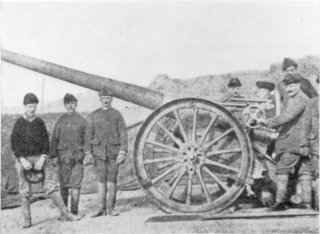
4.7 in QF on 6in howitzer carriage -
this illustrates
the unusual appearance
of a long-barrelled gun
mounted on a howitzer carriage
4.7 in QF on 6 in howitzer carriage
| Calibre | 4.7 in |
| Weight of gun | 42 cwt |
| Weight of gun carriage packed | 86 cwt |
| Weight behind the gun team | 98 cwt |
| Ammunition | Common and shrapnel |
| Weight of shell: Common | 46 lbs 9 ozs |
| Shrapnel | 45 lbs |
| Range: Percussion | 10,000 yds |
| Time fuze | 6,000 yds |
This was the same as the gun used by the Royal Navy, but it was mounted on a 6 in howitzer carriage. It was the armament of one of the two companies comprising the siege train. Other RGA Companies were similarly equipped while some took over the naval guns mounted on Captain Scott's carriages.
This version was preferred to the naval one. It weighed nearly a ton less and it also had little recoil when fired with 40 pr recoil scotches. Nevertheless, it was lively in action, as it was not the original intention to put a high velocity gun, 16 feet in length, on a howitzer carriage.
It had a three-motion breech mechanism, but this was considered better than the electrical single-action mechanism of the naval guns, as electrical firing was not satisfactory in the field.
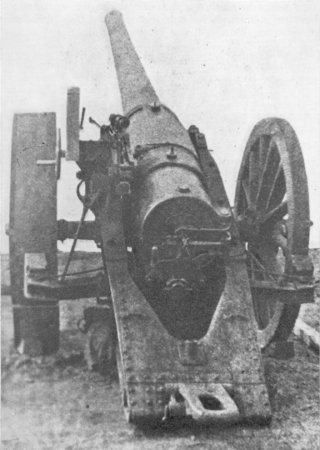
4.7 in QF on 6in howitzer carriage
- to improve mobility
experiments were carried out
with wide wheels
It was towed by as many as 24 oxen, muzzle forward, guided by hand, with a small limber at the rear. Two guns with 'improved carriages' had the limbers forward. It could also be towed by traction engines, but this development was not viewed with favour by all. Oxen could always be relied on, while the traction engine relied on a supply of fuel, and there was always the chance of 'breakages to machinery'.
Differences in the weights of common and shrapnel shell caused the two to range differently, and this presented difficulties.
5 in BL on 40 pr RML carriage
| Calibre | 5 in |
| Weight of gun | 40 cwt |
| Weight of gun carriage packed | 74 cwt |
| Weight behind the gun team | 89 cwt |
| Ammunition | Common and sharpnel |
| Weight of shell | 50 lbs |
| Range: Percussion | 10,500 yds |
| Time fuze | 5,400 yds |
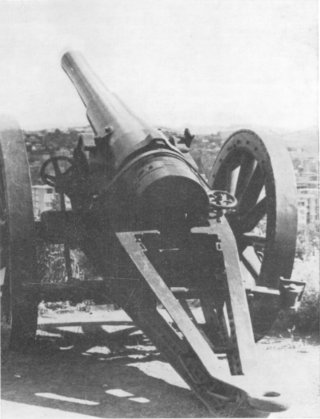
5 in BL on 40 pr RML carriage -
this gun is in front of
the Union Buildings in Pretoria.
Note the brakes
The 5 in BL was mounted on a 40 pr RML carriage, as was the 6.3 in howitzer RML. It was considered to be accurate to 7,000 yds, fairly accurate to 8,500 yds and serviceable up to 11,000 yds. (Compare this maximum range, quoted in the RAI Proceedings, with The Times History figures above.)
It was found that the recoil checking arrangements were inadequate. There were no brakes or recoil scotches initially, and on occasion guns turned completely over in recoil. here was no buffer. Later, Cape brakes were fitted, recoil scotches provided and recoil control improved.
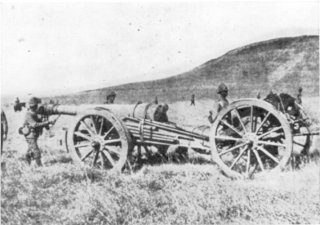
5 in BL on 40 pr RML carriage -
on the march. A retaining strap
over the breech steadies the gun
while on the move
It was felt by some that this equipment could not be compared with the 4.7 in on 6 in howitzer carriage, as the latter had as much shell power, greater MV and greater accuracy. On the other hand, the weight behind the 5 in gun team was slightly less than that of the 4.7 in. Batteries equipped with the 5 in felt that the greater simplicity of the carriage, the nominal superiority of the shell and their familiarity with the equipment, gave it preference
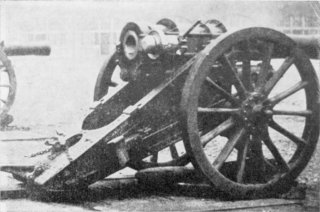
6 in Howitzer BL -
the equipment of
the Siege Train
on its special platform
6 in HOWITZER BL
| Calibre | 6 in |
| Weight of gun | 30 cwt |
| Weight of gun carriage packed | 69 cwt 3 qtrs 8 lbs |
| Weight behind the gun team | 85 cwt 0 qtrs 2 lbs |
| Ammunition | Common shell |
| Weight of shell | 120 lbs |
| Range | 5,200 yds |
At the outbreak of war, this was the equipment of one of the two companies in the siege train. Being specifically intended for this role, it was an interesting gun.
It was designed to fire from a platform to which the tension, hydraulic buffer was attached. In this configuration, it had an elevation of 35 degrees. If greater elevation was required, the wheels were removed and the carriage placed on the platform. A top carriage was then placed on the normal carriage, and an elevation of 70 degrees could then be achieved.
This capability was designed for distinct siege operation, and in South Africa the need for this did not arise. In this theatre the platform was an encumbrance, and it was discovered that it could be dispensed with. There are no reports of the top carriage being used.
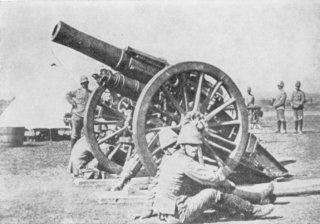
6 in Howitzer BL -
in South Africa
The ammunition was heavy and the range short. Several charges were available so that the angle of descent could be varied. In 1901 a 100 lb shell was introduced and, with this, the range was increased to 7,000 yds.
6.3 in HOWITZER RML
| Calibre | 6.3 in |
| Weight of gun | 18 cwt |
| Ammunition | Common, star, case |
| Weight of shell: Common | 72 lbs |
| Star | 11 lbs |
| Case | 49 lbs 14.5 ozs |
| Range: Common | 4,000 yds |
The 6.3 in howitzer came into service in the British Army in 1878. Two were in Port Elizabeth at the outbreak of war and were sent urgently to Ladysmith just before the siege. Known as Castor and Pollux, they were a welcome addition to the defences. One gun was with the Boer forces and was captured when Johannesburg fell.
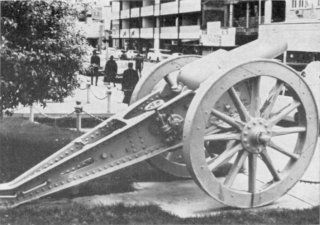
6.3 in Howitzer RML -
note that the carriage is the same
as that of the 5 in BL
Up till 1878, a rifled muzzle loader's shell had projecting studs which slotted into the rifling. This system had proved unsatisfactory as excessive windage caused considerable erosion in the bore. It was necessary, therefore, to devise some means of preventing the forward escape of gases when the gun was fired.
The first solution was a papier mache cup which was placed between the base of the shell and the cartridge. This was called a gas-check. It was found that, apart from preventing windage, the gas-check increased the range of the gun.
After several experiments, copper was found to be the best check, and it was adopted in 1878. At this time the gas-check was not fitted to the base of the shell but rotated independently. When it was suggested that it might, by being fixed to the shell, also be used to impart rotation, the studs on the shell were dispensed with and the gas-check became the driving band. This development was first applied with this equipment. Today, every shell has a driving band.
Castor and Pollux now stand in front of Ladysmith Town Hall.
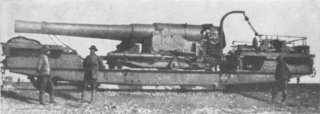
9.2 in BL - this photograph
was
taken in Belfast
in August 1900
9.2 in BL
| Calibre | 9.2 in |
| Weight of gun complete | 22 tons |
| Ammunition | Common shell |
| Weight of shell | 380 lbs |
| Range | 14,000 yds |
Manned by the Cape Garrison Artillery, this gun was dismounted from the Cape Town defences and placed upon a railway truck. It got as far as Belfast but was too late for the action at Bergendal. It was the only one of its kind sent to the front.
9.45 in HOWITZER BL
| Calibre | 9.45 in/24 cm |
| Weight of gun complete | 9 tons approx. |
| Ammunition | Common shell |
| Weight of shell | 280 lbs. |
In November 1899, four 24 cm howitzers on mobile mountings were being made by Skoda of Pilsen. When it was discovered that a German agent was negotiating with a view to purchase, it was realised that the ultimate destination would probably be the Transvaal.
The British moved in and, by February 1900, a deal had been effected. Officers were sent to Pilsen to learn the workings of the guns and a company was despatched to South Africa in order to receive them.
After all this, their services were not required in this theatre. They fired only one round, when a picquet on a hill outside Pretoria was attacked. The officer commanding had been waiting for weeks for the chance of a shot. When he spotted the enemy, he promptly supported the picquet by firing a round over their heads at the Boers who were frightened away.
When trouble started in China, the guns were sent there, but once again
there was to be disappointment. Peking was captured without their aid,
and they returned to England without having had the opportunity to prove
their worth. No photographs are available.
PART 6
MISCELLANEOUS
Various other guns saw service in South Africa, but none was significant.
Some, however, caught the imagination of the public and are described here.
They were:
37 mm Maxim automatic machine gun ('Pom-Pom')
'Lord Nelson'
'The Wolf'
4.1 in BL 'Long Cecil'
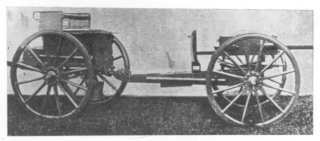
37 mm Maxim Automatic Machine Gun
('Pom-Pom') - a shield was normally fitted
| Calibre | 37 mm/l.5 in |
| Weight behind the gun team | 27 cwt |
| Ammunition | Explosive rounds |
| Weight of round | 1 lb |
| Range | 3,000 yds approx. |
This weapon was originally used by the Boers, and has already been described in Part 3. After their success with it in the early battles, 57 were ordered for the British Army. Three arrived in time for Paardeberg.
On the British side it filled the gap between the machine gun and the RHA 12 pr. It was useful in reconnaissance work, for driving off snipers and for preventing small parties from checking mounted troops. It often proved of the greatest service when used boldly. Its burst could easily be seen, and it proved a useful practical range-finder for the infantry.
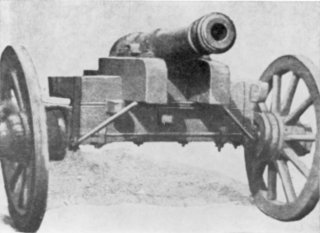
'Lord Nelson" - made in 1770,
it was used in Mafeking during the siege
'LORD NELSON'
Constructed in 1770, this old gun was used in Mafeking during the siege. It had originally been presented to Montsioa, a local chief, but had then lain buried for 20 years. At the beginning of the siege it was unearthed and handed over to the military by Wessels, Montsioa's son.
It was a smooth-bore muzzle loader, over a century old, firing round
balls, and, curiously, the initials of the founder, stamped on it, were
'BP and Co'.
'THE WOLF'
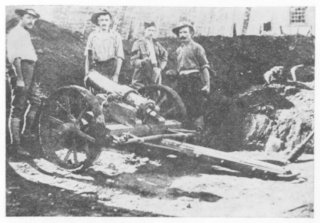
'The Wolf' - made in Mafeking
and used during the siege
| Calibre | 6 in |
| Weight of shell | 18 lbs |
| Range | 4,000 yds approx. |
This gun and its ammunition were made in Mafeking. It was used during
the siege.
4.1 in BL ('Long Cecil')
| Calibre | 4.1 in |
| Weight of gun | 2,800 lbs |
| Weight of gun complete | 3 tons |
| Ammunition | Common shell |
| Weight of shell | 28.25 lbs |
| Range | 7,000 yds approx. |
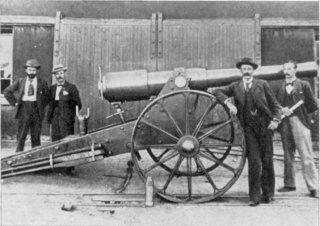
'Long Cecil' -
Mr Labram is leaning on the wheel
At the beginning of the siege, the artillery defence of Kimberley consisted only of 7 prs and 2.5 in RMLs. An American engineer with de Beers, Mr George Labram, therefore, suggested that he should attempt to make a gun of a calibre better able to deal with the Boer guns. This gun was designed and constructed by engineers who had no previous experience of ordnance manufacture, without special plant or arrangements, and on designs adapted from descriptions found in a stray copy of an engineering journal.
Its construction, from the day that designs were fashioned, took 24 days and, on the next day, it was in action against the enemy. During the first few days, it occasionally broke down, but the defects were soon remedied and it remained in action until the end of the siege.
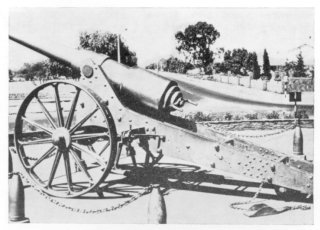
'Long Cecil' - as the gun
appears in Kimberley today
'Long Cecil' fired 225 shells against the Boers at an average range of 5,000 yds. Its activity forced the Boers to send for a 'Long Tom'. Ironically, Mr Labram was killed by one of the first shells that this 'Long Tom' fired into Kimberley. 'Long Cecil' can still be seen in Kimberley, where it stands in memory of those who defended the town during the siege.
CONCLUSION
Apart from describing the guns in use in South Africa, this review illustrates, to a certain extent, the thinking and tactics of both sides. Although some of their equipment was superior, the Boers nevertheless failed to derive full benefit from this advantage. This was partly because of their methods, and partly because their artillery was outnumbered in the field - increasingly so as time went on.
In most cases the British guns were inferior, but they were used boldly and discipline was very good. The British concentrated their fire more than did the Boers, and this helped them overcome their difficulties. Nevertheless, three years of war convinced the Royal Artillery that they must develop new guns, and improve the tactical handling of artillery in the field. The lessons they learnt in South Africa were to stand them in good stead in 1914.
Return to Journal Index OR Society's
Home page